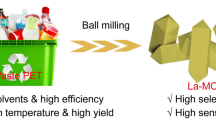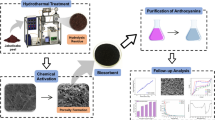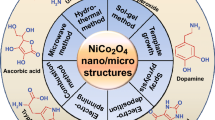Abstract
Based on platinum nanoparticle–embedded raspberry-liked SiO2, a sensitive and selective electrochemical sensor was developed for simultaneous determination of eugenol (EU) and methyleugenol (MEU). Raspberry-liked SiO2 (RL-SiO2) was characterized with open pores on the surface, which can be used as a path for utilizing the inner space fully. So, platinum nanoparticles (Pt NPs) could be embedded in the inner and outer surface of RL-SiO2. As a carrier, RL-SiO2 not only avoided the agglomeration of the Pt NPs but also improved the catalytic performance. Therefore, the prepared Pt NPs@RL-SiO2/GCE exhibited excellent electrocatalytic activity for simultaneous determination of EU and MEU; the linearity ranges were 0.50 ~ 60 μmol/L for EU at a working potential of 0.65 V (vs. saturated calomel electrode) and 0.50 ~ 50 μmol/L for MEU at a working potential of 1.10 V; the detection limits were 0.12 μmol/L and 0.16 μmol/L (S/N=3); and the relative standard deviations (RSDs) were 3.2% and 4.5%, respectively. In addition, Pt NPs@RL-SiO2/GCE was successfully applied to the analysis of fish samples; the obtained recoveries were between 92.0 and 107%. Notably, the results conducted on samples were highly consistent with those obtained from high-performance liquid chromatography. It can be concluded that the study provided a simple method for simultaneous electrochemical determination of EU and MEU in fish samples.
Graphical abstract

Schematic illustration of the preparation of RL-SiO2@Pt NPs/GCE for simultaneous determination of eugenol and methyleugenol in fish samples.









Similar content being viewed by others
References
Romaneli RDS, Boaratti AZ, Rodrigues AT, Queiroz DMDA, Khan KU, Nascimento TMT, Fernandes JBK, Mansano CFM (2018) Efficacy of benzocaine, eugenol, and menthol as anesthetics for freshwater angelfish. J Aquat Anim Health 30:210–216. https://doi.org/10.1002/aah.10030
Cupp AR, Hartleb CF, Fredricks KT, Gaikowski MP (2016) Effectiveness of eugenol sedation to reduce the metabolic rates of cool and warm water fish at high loading densities. Aquac Res 47:234–242. https://doi.org/10.1111/are.12485
Scherpenisse P, Bergwerff AA (2007) Determination of residues of tricaine in fish using liquid chromatography tandem mass spectrometry. Anal Chim Acta 586:407–410. https://doi.org/10.1016/j.aca.2006.11.008
U.S.Department of Health and Human Services Food and Drug Administration Center for Veterinary Medicine. Guidance for industry concerns related to the use of Clove oil as an anesthetic for fish [EB/OL] (200704-24)[2018-08-15]. http://www.Fda.gov/downloads/AnimalVeterinary/Guidance Compliance Enforcement/Guidance for Industry/ucm0525520.pdf.
International Agency for Research on Cancer (IARC)-Summaries&Evaluationsvolume36: eugenol [EB/OL]. http://www.inchem.org/documents/iarc/vol36/eugenol.html.
AFS policy statement regarding the need for an immediate-release Anesthetic/Sed-ative for use in the Fisheries Disciplines [EB/OL]. http://www.fishculture/Section.org.
Chen H, Huang H, Gao P, Huang GF, Liu WX, Li ZQ (2014) Determination of clove phenol drug residues in aquatic products by high performance liquid chromatography. Food and Fermentation Industries 40:156–160. https://doi.org/10.13995/j.cnki.11-1802/ts.201412030
Yun SM, Lee MH, Lee KJ, Ku HO, Son SW, Joo YS (2010) Quantitative analysis of eugenol in clove extract by a validated HPLC method. J AOAC Int 93:1806–1810. https://doi.org/10.1093/jaoac/93.6.1806
Cantalapiedra A, Jesus Gismera M, Teresa Sevilla M, Procopio JR (2014) Sensitive and selective determination of phenolic compounds from aromatic plants using an electrochemical detection coupled with HPLC method. Phytochem Anal 25:247–254. https://doi.org/10.1002/pca.2500
Trujillo-Rodriguez MJ, Yu H, Cole WTS, Ho TD, Pino V, Anderson JL, Afonso AM (2014) Polymeric ionic liquid coatings versus commercial solid-phase microextraction coatings for the determination of volatile compounds in cheeses. Talanta 121:153–162. https://doi.org/10.1016/j.talanta.2013.12.046
Beaudry F, Guenette SA, Vachon P (2006) Determination of eugenol in rat plasma by liquid chromatography-quadrupole ion trap mass spectrometry using a simple off-line dansyl chloride derivatization reaction to enhance signal intensity. Biomed Chromatogr 20:1216–1222. https://doi.org/10.1002/bmc.687
Schulz K, Schlenz K, Malt S, Metasch R, Roemhild W, Dressler J, Lachenmeier DW (2008) Headspace solid-phase microextraction-gas chromatography-mass spectrometry for the quantitative determination of the characteristic flavouring agent eugenol in serum samples after enzymatic cleavage to validate post-offence alcohol drinking claims. J Chromatogr A 1211:113–119. https://doi.org/10.1016/j.chroma.2008.09.068
Sgorbini B, Ruosi MR, Cordero C, Liberto E, Rubiolo P, Bicchi C (2010) Quantitative determination of some volatile suspected allergens in cosmetic creams spread on skin by direct contact sorptive tape extraction-gas chromatography-mass spectrometry. J Chromatogr A 1217:2599–2605. https://doi.org/10.1016/j.chroma.2009.12.052
Claudia Lopez J, Alicia Zon M, Fernandez H, Marcelo Granero A (2020) Development of an enzymatic biosensor to determine eugenol in dental samples. Talanta 210:1–8. https://doi.org/10.1016/j.talanta.2019.120647
Tonello N, Beatriz Moressi M, Noel Robledo S, D'Eramo F, Miguel Marioli J (2016) Square wave voltammetry with multivariate calibration tools for determination of eugenol, carvacrol and thymol in honey. Talanta 158:306–314. https://doi.org/10.1016/j.talanta.2016.05.071
Yildiz G, Aydogmus Z, Cinar ME, Senkal F, Ozturk T (2017) Electrochemical oxidation mechanism of eugenol on graphene modified carbon paste electrode and its analytical application to pharmaceutical analysis. Talanta 173:1–8. https://doi.org/10.1016/j.talanta.2017.05.056
Saglam O, Dilgin DG, Ertek B, Dilgin Y (2016) Differential pulse voltammetric determination of eugenol at a pencil graphite electrode. Materials Science & Engineering C-Materials for Biological Applications 60:156–162. https://doi.org/10.1016/j.msec.2015.11.031
Garg A, Gupta B, Prakash R, Singh S (2010) Preparation and characterization of hydroxypropyl-beta-cyclodextrin inclusion complex of eugenol: differential pulse voltammetry and H-1-NMR. Chem Pharm Bull 58:1313–1319. https://doi.org/10.1248/cpb.58.1313
Huang J, Tian J, Zhao Y, Zhao S (2015) Ag/Au nanoparticles coated graphene electrochemical sensor for ultrasensitive analysis of carcinoembryonic antigen in clinical immunoassay. Sensors and Actuators B-Chemical 206:570–576. https://doi.org/10.1016/j.snb.2014.09.119
Wang B, Jing R, Qi H, Gao Q, Zhang C (2016) Label-free electrochemical impedance peptide-based biosensor for the detection of cardiac troponin I incorporating gold nanoparticles modified carbon electrode. J Electroanal Chem 781:212–217. https://doi.org/10.1016/j.jelechem.2016.08.005
Vatanparast J, Khalili S, Naseh M (2017) Dual effects of eugenol on the neuronal excitability: An in vitro study. Neurotoxicology 58:84–91. https://doi.org/10.1016/j.neuro.2016.11.011
Hwang SM, Lee K, Im ST, Go EJ, Kim YH, Park CK (2020) Co-application of eugenol and QX-314 elicits the prolonged blockade of voltage-gated sodium channels in nociceptive trigeminal ganglion neurons. Biomolecules 10:1513. https://doi.org/10.3390/biom10111513
Krishnan S, Tong L, Liu S (2020) A mesoporous silver-doped TiO2-SnO2 nanocomposite on g-C3N4 nanosheets and decorated with a hierarchical core−shell metal-organic framework for simultaneous voltammetric determination of ascorbic acid, dopamine and uric acid. Microchim Acta 187:82. https://doi.org/10.1007/s00604-019-4045-x
Chen XM, Shi ZX, Hu YF, Xiao XH, Li GK (2018) A novel electrochemical sensor based on Fe3O4-doped nanoporous carbon for simultaneous determination of diethylstilbestrol and 17β-estradiol in toner. https://doi.org/10.1016/j.talanta.2018.05.063
Ma L, Wang C, Gong M, Liao L, Long,R, Wang J, Wu D, Zhong W, Kim MJ, Chen Y, Xie Y, Xiong Y (2012) Control over the branched structures of platinum nanocrystals for electrocatalytic applications. ACS Nano 6: 9797-9806. https://doi.org/10.1021/nn304237u.
Hu X, Zhang R (2016) Voltammetric determination of the endocrine disruptor diethylstilbestrol by using a glassy carbon electrode modified with a composite consisting of platinum nanoparticles and multiwalled carbon nanotubes. Microchim Acta 183:3069–3076. https://doi.org/10.1007/s00604-016-1960-y
Zhang J, Qu X, Han Y, Shen L, Yin S, Li G, Jiang Y, Sun S (2020) Engineering PtRu bimetallic nanoparticles with adjustable alloying degree for methanol electrooxidation: Enhanced catalytic performance. Applied Catalysis B-Environmental 263:118345. https://doi.org/10.1016/j.apcatb.2019.118345
Kong FY, Li RF, Yao L (2019) An electrochemical daunorubicin sensor based on the use of platinum nanoparticles loaded onto a nanocomposite prepared from nitrogen decorated reduced graphene oxide and single-walled carbon nanotubes. Microchim Acta 186:321. https://doi.org/10.1007/s00604-019-3456-z
Zhang C, Fan Y, Zhang H, Chen S, Yuan R (2019) An ultrasensitive signal-on electrochemiluminescence biosensor based on Au nanoclusters for detecting acetylthiocholine. Anal Bioanal Chem 411:905–913. https://doi.org/10.1007/s00216-018-1513-9
Wang Q, Huang X, Long Y, Wang X, Zhang H, Zhu R, Liang L, Teng P, Zheng H (2013) Hollow luminescent carbon dots for drug delivery. Carbon 59:192–199. https://doi.org/10.1016/j.carbon.2013.03.009
Tang X, Liu ZH, Zhang C, Yang Z, Wang Z (2009) Synthesis and capacitive property of hierarchical hollow manganese oxide nanospheres with large specific surface area. J Power Sources 193:939–943. https://doi.org/10.1016/j.jpowsour.2009.04.037
Liang J, Hu H, Park H, Xiao C, Ding S, Paik U, Lou XW (2015) Construction of hybrid bowl-like structures by anchoring NiO nanosheets on flat carbon hollow particles with enhanced lithium storage properties. Energy Environ Sci 8:1707–1711. https://doi.org/10.1039/C5EE01125F
Zhou C, Han J, Song G, Guo R (2008) Fabrication of poly (aniline-co-pyrrole) hollow nanospheres with Triton X-100 micelles as templates. Journal of Polymer Science Part a-Polymer Chemistry 46:3563–3572. https://doi.org/10.1002/pola.22695
Cheng Y, Niu X, Zhao T, Yuan F, Zhu Y, Fu H (2013) Hydrothermal synthesis of Cu@C composite spheres by a one-step method and their use as sacrificial templates to synthesize a CuO@SiO2 core-shell structure. Eur J Inorg Chem 2013:4988–4997. https://doi.org/10.1002/ejic.201300624
Teranishi T, Hosoe M, Tanaka T, Miyake M (1999) Size control of monodispersed Pt nanoparticles and their 2D organization by electrophoretic deposition. J Phys Chem B 103:3818–3827. https://doi.org/10.1021/jp983478m
Liu Y, Li Z, Xu S, Xie Y, Ye Y, Zou X, Lin S (2019) Synthesis of Pt-Ni (trace)/GNs composite and its bi-functional electrocatalytic properties for MOR and ORR. J Colloid Interface Sci 554:640–649. https://doi.org/10.1016/j.jcis.2019.07.052
Najafi-Ashtiani H (2018) Performance evaluation of free-silicon organic-inorganic hybrid (SiO2-TiO2-PVP) thin films as a gate dielectric. Appl Surf Sci 455:373–378. https://doi.org/10.1016/j.apsusc.2018.06.010
Dong W, Sun Y, Lee CW, Hua W, Lu X, Shi Y, Zhang S, Chen J, Zhao D (2007) Controllable and repeatable synthesis of thermally stable anatase nanocrystal-silica composites with highly ordered hexagonal mesostructures. J Am Chem Soc 129:13894–13904. https://doi.org/10.1021/ja073804o
Li B, Xu Z, Jing F, Luo S, Chu W (2017) Facile one-pot synthesized ordered mesoporous Mg-SBA-15 supported PtSn catalysts for propane dehydrogenation. Applied Catalysis a-General 533:17–27. https://doi.org/10.1016/j.apcata.2016.12.026
Wu P, Cao Y, Wang Y, Xing W, Zhong Z, Bai P, Yan Z (2018) Ultrastable bimetallic catalyst with tuned surface electronic properties for highly selective oxidation of cyclohexane. Appl Surf Sci 457:580–590. https://doi.org/10.1016/j.apsusc.2018.06.300
Anson FC (1969) Application of potentiostatic current integration to the study of the adsorption of cobalt (III)-Ethylenedinitrilo (tetraacetate) on mercury electrodes. Anal Chem 75:313–315. https://doi.org/10.1021/ac60210a068
Ji L, Wang Y, Wu K, Zhang W (2016) Simultaneous determination of environmental estrogens: Diethylstilbestrol and estradiol using Cu-BTC frameworks-sensitized electrode. Talanta 159:215–221. https://doi.org/10.1016/j.talanta.2016.06.030
Gan T, Shi ZX, Liu N, Lv Z, Sun JY, Wang HB (2015) A novel electrochemical sensing strategy for rapid and ultrasensitive detection of 6-benzylaminopurine in sprout vegetables by hollow core/Shell-structured CuO@SiO2 microspheres. Food Anal Methods 8:2504–2514. https://doi.org/10.1007/s12161-015-0140-8
Gan T, Shi ZX, Hu DY, Lv Z, Sun JY, Liu YM (2016) Preparation of yolk–shell structured copper oxide@silica oxide spheres and their application in high performance electrochemical sensing of Formoterol fumarate residues in swine feed and tissues. Food Chem 190:544–551. https://doi.org/10.1016/j.foodchem.2015.05.132
Gan T, Wang Z, Gap J, Sun J, Wu K, Wang H, Liu Y (2019) Morphology-dependent electrochemical activity of Cu2O polyhedrons and construction of sensor for simultaneous determination of phenolic compounds with graphene oxide as reinforcement. Sensors and Actuators B-Chemical 282:549–558. https://doi.org/10.1016/j.snb.2018.11.102
Laviron E (1974) Adsorption, autoinhibition and autocatalysis in polarography and in linear potential sweep voltammetry. J Electroanal Chem Interfacial Electrochem 52:355–393. https://doi.org/10.1016/S0022-0728(74)80448-1
Ahmad H, Zhao LH, Liu CK, Cai CJ, Ma FQ (2021) Ultrasound assisted dispersive solid phase microextraction of inorganic arsenic from food and water samples using CdS nanoflowers combined with ICP-OES determination. Food Chem 338:128028. https://doi.org/10.1016/j.foodchem.2020.128393
Chen X, Guo ZW, Zhang JJ, Li YY, Duan R (2021) A new method for determining the denaturation temperature of collagen. Food Chem 343:128393. https://doi.org/10.1016/j.foodchem.2020.128393
Ziyatdinova G, Ziganshina E, Romashkina S, Budnikov H (2017) Highly sensitive amperometric sensor for eugenol quantification based on CeO2 nanoparticles and surfactants. Electroanalysis 29:1197–1204. https://doi.org/10.1002/elan.201600719
Ziyatdinova G, Ziganshina E, Budnikov H (2013) Voltammetric sensing and quantification of eugenol using nonionic surfactant self-organized media. Anal Methods 5:4750–4756. https://doi.org/10.1039/C3AY40693H
Naskar H, Ghatak B, Biswas S, Singh PP, Tudu B, Bandyopadhyay R (2020) Electrochemical detection of eugenol (EU) using polyacrylonitrile molecular imprinted polymer embedded graphite (PAN-MIP/G) electrode. IEEE Sensors J 20:39–46. https://doi.org/10.1109/JSEN.2019.2941637
Wang S, Zhang T, Wang Z, Wang D, Wang Z, Sun M, Song X, Liu H (2019) Direct electrochemistry of eugenol at a glassy carbon electrode modified with electrochemically reduced graphene oxide. International Journal of Electrochemical Science 14: 3618-3627. https://doi.org/10.20964/2019.04.27.
Feng Q, Duan K, Ye X, Lu D, Du Y, Wang C (2014) A novel way for detection of eugenol via poly (diallyldimethylammonium chloride) functionalized graphene-MoS2 nanoflower fabricated electrochemical. Sensors Actuators B Chem 192:1–8. https://doi.org/10.1016/j.snb.2013.10.087
Afzali D, Zarei S, Fathirad F, Mostafavi A (2014) Gold nanoparticles modified carbon paste electrode for differential pulse voltammetric determination of eugenol. Mater Sci Eng C 43:97–101. https://doi.org/10.1016/j.msec.2014.06.035
Lin X, Ni Y, Kokot S (2014) Electrochemical mechanism of eugenol at a doped gold nanoparticles modified glassy carbon electrode and its analytical application in food samples. Electrochim Acta 133:484–491. https://doi.org/10.1016/j.electacta.2014.04.065
Yang L, Zhao F, Zeng B (2016) Electrochemical determination of eugenol using a threedimensional molecularly imprinted poly (p-aminothiophenol-co-p-aminobenzoic acids) film modified electrode. Electrochim Acta 210:293–300. https://doi.org/10.1016/j.electacta.2016.05.167
He RP, Lei B, Su YP, Wang AL, Cui KP, Shi XK, Chen XM (2020) Effectiveness of eugenol as an anesthetic for adult spotted sea bass (Lateolabrax maculatus). Aquaculture 523:735180. https://doi.org/10.1016/j.aquaculture.2020.735180
Funding
This work was supported by the Research and Development Plan for Key Areas of Food Safety in Guangdong Province of China (No. 2019B020211001), the National Key Research and Development Program of China (No. 2019YFC1606101), and the National Natural Science Foundation of China (Nos. 21976213 and 21775167), respectively.
Author information
Authors and Affiliations
Corresponding authors
Ethics declarations
Conflict of interest
The authors declare that they have no competing interests.
Additional information
Publisher’s note
Springer Nature remains neutral with regard to jurisdictional claims in published maps and institutional affiliations.
Supplementary Information
ESM 1
(DOCX 8142 kb)
Rights and permissions
About this article
Cite this article
Shi, Z., Xia, L., Li, G. et al. Platinum nanoparticles-embedded raspberry-liked SiO2 for the simultaneous electrochemical determination of eugenol and methyleugenol. Microchim Acta 188, 241 (2021). https://doi.org/10.1007/s00604-021-04892-0
Received:
Accepted:
Published:
DOI: https://doi.org/10.1007/s00604-021-04892-0




